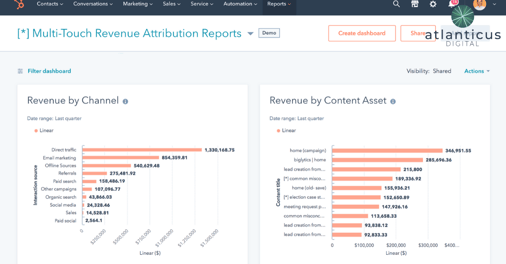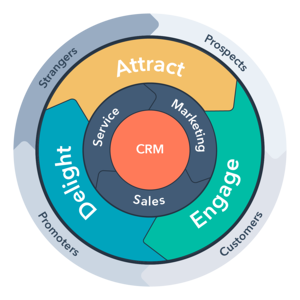Aligning the marketing, sales, and service teams can benefit your company immensely. From higher customer retention to better deal closing and increased growth rate, aligning the teams is essential. According to statistics, most sales and marketing leaders agree that collaborating between sales and marketing teams enables critical business growth, with some sources estimating a 20% annual growth rate.
Research also shows that companies adopting sales and marketing functions are 67% better at closing deals and enjoy a 36% more customer retention rate. Overall, aligning the departments can boost revenue generation from marketing by more than 200%.
In this post, we discuss marketing, sales, and service teams' alignment, how it can benefit your company, the roles of the teams in the customer lifecycle stage, and tools that enable alignment.
How CRM Can Align Sales, Marketing, and Service Departments
Aligning sales, marketing, and service departments is one of the smartest strategies for achieving overall organisational growth. When the teams operate in silos, inefficiencies and wastage of resources due to duplication of efforts are a perpetual headache that slows down companies.
Actually, the teams have traditionally been rocked in conflicts that never seem to end. But with CRM, they collaborate easily, leading to improved efficiency. From lead management and nurturing to sharing goals and metrics, CRM bridges the gap, streamlining the customer lifecycle for improved performance.
Let's look at how CRM helps align sales, marketing, and service functions.
Improved Interdepartmental Communication
The HubSpot CRM gathers loads of valuable customer information for the marketing, sales, and service functions, which the teams can access from a single dashboard. With the functions aligned, the risk of miscommunication is minimised, increasing their efficiency. Effectively, this eliminates interdepartmental conflict significantly.

Increased Deal Size
Marketing automation allows the teams to continue gathering more data about the leads, enabling them to evaluate, pitch, and support them. Especially the information gathered, e.g., company size, goals, pain points, buying authority, etc., allows the sales team to explore upselling opportunities.

Offers Deeper Insights
HubSpot CRM allows the teams to access all the prospects' contact information from a single dashboard. They can also retrieve additional information such as competitors, company background, brand interaction, etc. As the data is updated in real-time, it's immensely beneficial to the teams in evaluating and optimising their strategies.

Nurturing Leads into Opportunities
Most leads don't convert into sales due to a lack of nurturance. Once acquired, the teams must actively employ strategies to nurture the leads to conversion. The marketing team needs to run targeted campaigns to nudge the leads down the funnel, whereby the sales team can offer personalised deals to match their specific needs and convert them.
CRM provides the teams – marketing, sales, and service – with all the important customer data required to segment the audience and conduct personalised campaigns and customer service. Besides, with the information integrated and accessible from a single dashboard, the customer journey is well-streamlined.

Sharing Goals and Expectations
CRM eliminates segregated team efforts by enabling collaboration between them. A smart alignment strategy involves the teams sharing their goals and expectations for a unified approach toward lead generation, nurturing, and scoring. As a result, it reduces the ambiguous expectations posed by siloed team efforts, eliminating inefficiencies and enhancing performance.

Avoid Duplicated Efforts
CRM allows the teams to view where the customer stands on the sales funnel. As such, the marketing team can share relevant content that suits the prospect at that point, while the sales team can focus on hot leads instead of wasting efforts on those not yet ready to convert.
In addition, reducing duplication of efforts eliminates the wastage of resources that you can channel to other revenue-generating avenues within the organisation.
Roles of Sales, Marketing, and Service in the Customer Lifecycle Stage
CRM software provides a clear view of the customer lifecycle, enabling the teams to nurture and seamlessly convert the prospects. Each team plays a crucial role at each stage of the lifecycle. 
Ideally, the cycle starts when the prospect becomes aware of the product through the buying process and after conversion. As HubSpot highlights, the cycle involves five stages – reach, acquisition, conversion, retention, and loyalty.
In the first stage – reach – the marketing team reaches out to the customer through inbound or outbound marketing. The lead learns about the product by researching the search engine, reading online reviews, social media, etc.
Then the customer enters the acquisition stage by calling you or visiting your website. If they call you immediately, your service team attends to their inquiry. At this point, they may proceed to the next stage, conversion, which involves the sales team closing the deal.
On the other hand, if they visit your website, they engage further with marketing content, which nurtures them until they're ready for conversion by the sales team. If they reach out to your customer support, the team will address their inquiry and guide them appropriately.
After conversion, your service team works at retaining the customer. They could request feedback, e.g., through a short survey to find out whether they have enjoyed their experience with your brand. Then the teams collaborate to roll out retention strategies (exclusive perks) to turn the customers into brand promoters, such as referral bonuses, discounts, etc.
A customer who reaches the loyalty stage is an asset to the company. They're likely to promote the company and purchase again from you. The sales team can reach out to them by cross-selling or upselling them based on their interests.
Tools You Can Use to Create Synergies in Your Marketing, Sales, and Service Teams
HubSpot offers a sea of tools that the marketing, sales, and service teams can leverage to enhance their communication, collaboration, productivity, task management, scheduling, data sharing, content creation, and more.
Examples of common tools include;
- Chatbots
- Forms
- Lists
- Workflows, etc.
The CRM has dozens of tools that enable marketing, sales, and service teams to collaborate and streamline the customer experience, improving efficiency and overall performance. Check the full list here.
Conclusion
Aligning your marketing, sales, and service teams is a crucial step toward increasing your efficiency and performance. It can increase customer retention, enhance your deal-closing ability, and boost your revenue. We hope this article has enlightened you on the importance of HubSpot CRM to your marketing, sales, and service teams and how they can collaborate to enhance the customer lifecycle.
Meanwhile, if you're in the construction or manufacturing industry looking for a reliable digital marketing services provider, look no further. As a Platinum HubSpot Agency Partner, we can help you tap into the powerful HubSpot marketing features to create personalised strategies that will delight, attract, and engage your customers. Contact us and let us assist you in leveraging the power of your marketing, sales, and service teams.



.jpg)